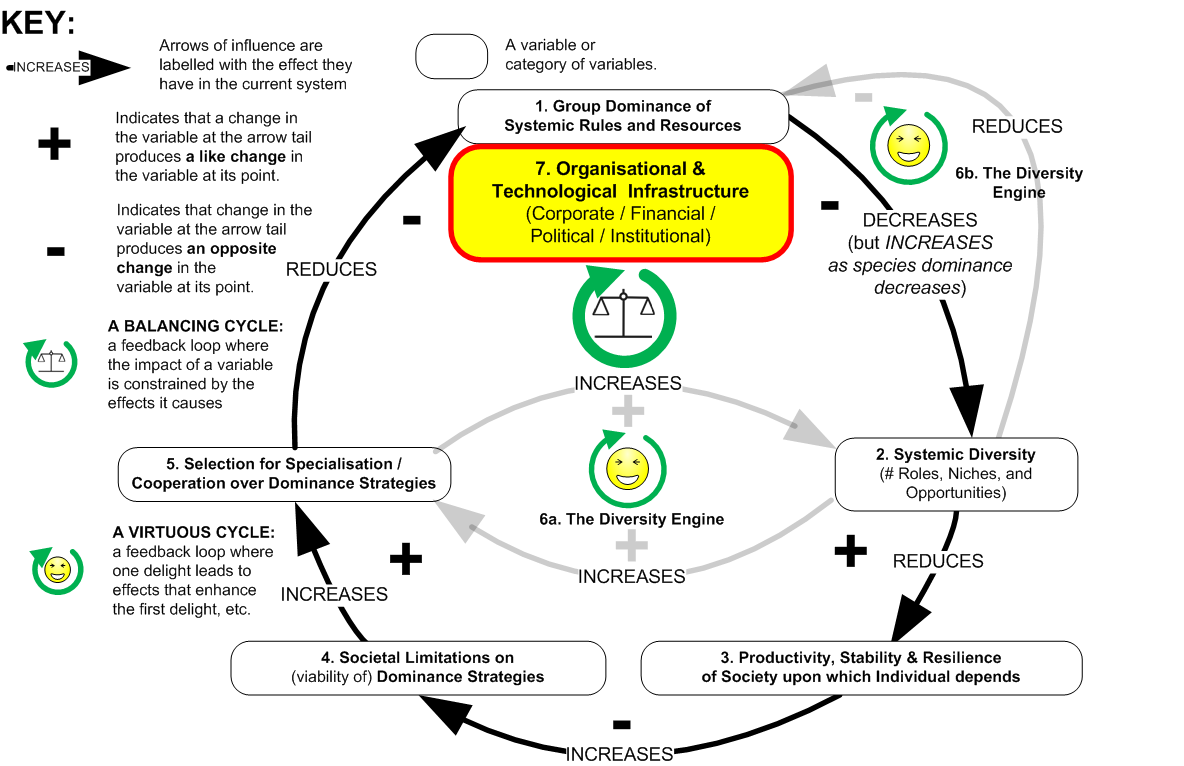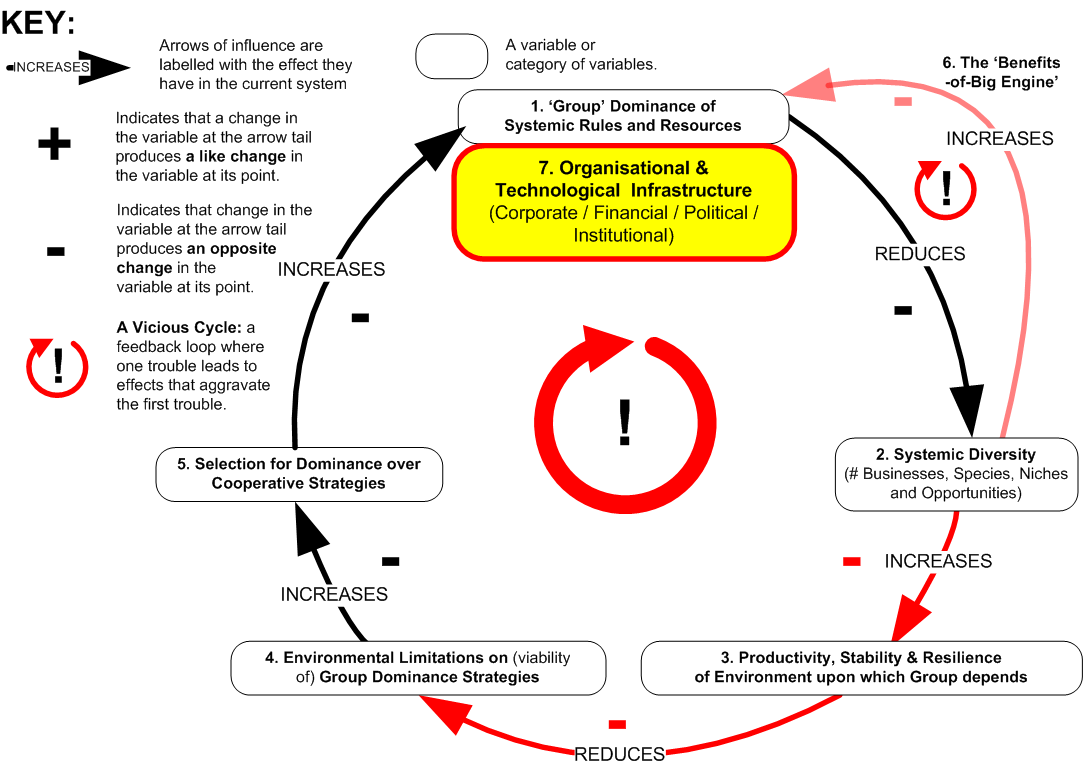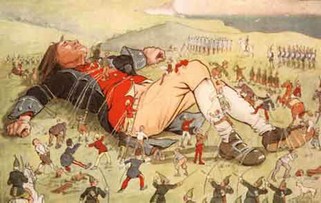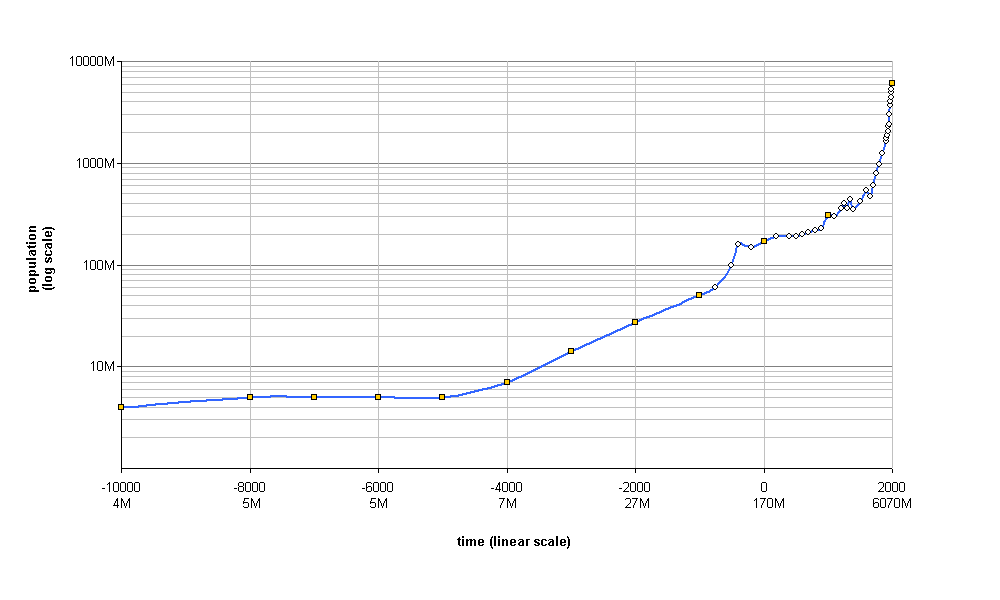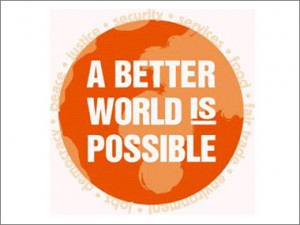Why Corporate Regulation is a Socioenvironmental Necessity. Part 5 of 5: How do We Create a Diverse and Stable Economic System?
Welcome to the belated final installment of our five part analysis. We have been working towards the title’s conclusion by seeking an answer to the following question.
What difference between natural / social, and economic, systems causes one to tend towards diversity and stability, and the other, uniformity and instability?
In installments 1, 2 and 3, we proposed that in natural / social systems a species or ‘group’ seeking total domination of their environment are constrained and, ultimately, destroyed by the impoverishing and destabilising effects of their actions on the systems upon which their own survival depends, thus leaving the arena open for dynamics that promote diversity and long-term stability (see previous installments if you need an explanation of the model below).
In installment 4 we suggested that the current economic system displays a reverse trend towards uniformity and instability because it allows the small ‘groups’ at the helms of corporations to gain increasing wealth and power from disintegrating social / natural systems without ever personally experiencing the environmental backlash of their actions. (see installment 4 if you need an explanation of the model below).
 To clarify, this shouldn’t be taken as a demonisation of businessmen. Some individuals are naturally entrepreneurial, status-driven or materially-oriented, and the prosperity and order we have come to enjoy in recent centuries are largely indebted to their spirit and energy. Indeed, there are few among us that wouldn’t pass up a lottery win and the prestige, security and freedom it affords.
To clarify, this shouldn’t be taken as a demonisation of businessmen. Some individuals are naturally entrepreneurial, status-driven or materially-oriented, and the prosperity and order we have come to enjoy in recent centuries are largely indebted to their spirit and energy. Indeed, there are few among us that wouldn’t pass up a lottery win and the prestige, security and freedom it affords.
However, in the current era, unconstrained profit-and-power motivated vicious cycles represent a mortal threat to our freedom of choice, quality of life and, most urgently, our planet’s life systems. If the virtuous feedback mechanisms that promote diversity and stability in natural / social systems do not function naturally in the current economic system, then they they must be imposed artificially with due haste. But how?
First let’s summarise, in a nutshell, the problem to be resolved…
In the current economic system, dominant ‘groups’ are able to benefit from abusing the diversity and stability of socioenvironmental systems without ever experiencing negative feedback from their actions.
Although many possible interventions occurred to Arkadian whilst writing this series, a coherent regulatory model, which offered an unobjectionable, easy transition from the current economic system was not so easy to imagine (the reason why the final installment has been so long in coming!). Happily, a fully-formed (40yr old) solution presented itself recently in Chapter 19 of ‘Small is Beautiful’, courtesy of the genius of economist, E.F. Schumacher (pictured left).
The Schumacher Business Model, stated simply, rests on 2 systemic ‘tweaks’: (1) limiting the number of people a single corporate entity can employ and (2) introducing meaningful public ownership and accountability into business structure and practice.
(1) Legally restricting corporation size by number of employees. It would seem reasonable that a ceiling should be dictated chiefly by evidence regarding effective human group size (see Dunbar’s number), say between 80-200 persons. Growth beyond the upper limit, Schumacher suggests, should entail the formation of new independent corporate units, which may be linked by joint stock. These restrictions would enable each employee to ’embrace the idea of the business as a whole’ and the value of their role therein, but most importantly to the current argument, it would ensure that ‘the group (i.e. The Board)’ couldn’t claim ignorance of the details of their company activities and, thus, could reasonably be held personally accountable for abuses.
Furthermore, constraining size, particularly when the exploitation of natural / social resources is involved, is also more likely to physically ground a corporation in a local environment. Bringing ‘the group’ closer to their employees and the raw coal face of their realworld transactions is likely to increase their susceptibility and responsiveness to negative socioenvironmental feedback both internal and external to their organisation. It is also liable to curb the scale of impacts of which a single corporate vehicle is capable.
All very well, the cynics may cry, but what of the ‘groups’ with the thicker skins and thinner moral fibre?
(2) Public Ownership and Accountability. Schumacher advises we put an end to annual corporate taxation (a proposition not disagreeable to most businessmen!). In its place he proposes that for every share sold privately by a company, a further share is issued to the public. Thus, as owner of 50% of the company, we’d collectively receive half of any dividends if and when they are paid out to shareholders (he argues that when a company grows beyond a certain size it loses its ‘private and personal character’ and thus can be considered, in a sense, a public enterprise anyway).
 To avoid disruption, our public equity wouldn’t allow us any voting rights in everyday business decision-making. It would, however, entitle us to attend Board meetings as an observer and, if the actions of the business were deemed to run counter to the public or environmental interest, we could apply to a court to get dormant voting rights activated.
To avoid disruption, our public equity wouldn’t allow us any voting rights in everyday business decision-making. It would, however, entitle us to attend Board meetings as an observer and, if the actions of the business were deemed to run counter to the public or environmental interest, we could apply to a court to get dormant voting rights activated.
To exercise these corporate responsibilities, Schumacher proposes the creation of independent citizen bodies funded from local business dividends. These ‘Social Councils’ would be split into four equal parts: three would have their members nominated by local trade unions, professional, and environmental, organisations, with the final quarter being drawn randomly from local residents in the manner of jury service. Involvement in management processes would, of course, be bound by strict confidentiality agreements.
Schumacher’s model brings socioenvironmental feedback directly into the Board room both as a ‘possibility in the background’ and, when necessary, as a real, prevailing constraint.
It is Arkadian’s prediction that, over time, exposing the ‘groups’ at the corporate helm to these balancing dynamics would drive a new trend towards macroeconomic diversity and stability, and greater corporate responsibility for the integrity of the natural environment (by triggering the ‘Diversity Engine’, described in installments 1, 2 and 3). And to top it all, it would require minimal design and economic / legal restructuring because, in the main, the model utilises existing frameworks and practices.
To conclude, effective corporate regulation is not just a Utopian nice-t0-have. It took till 1960 for World Population to hit 3bn. It has grown by 1bn approximately every 12yrs since, probably hitting the 7bn mark earlier this year. There are more human beings to house and feed today than have ever lived before. Presently, we have just over 2 acres of workable land each, 4x less than a century ago, and this is shrinking each moment as corporate activities and climate change destroy the natural world, and population continues to skyrocket.
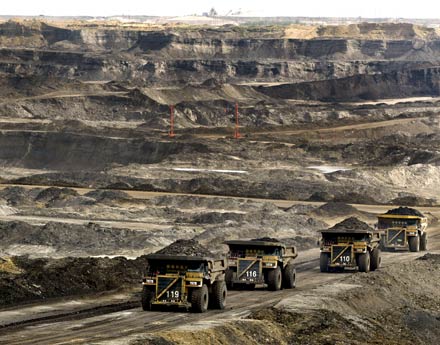 Resultant biodiversity loss, whilst often second-ranked in current ‘problem’ trends is, as we’ve established, probably the most dangerous of all due to its inscrutable relationship with macroenvironmental instability. With extinctions currently at 1000x the background base rate, and predicted to rise to 10,000x over this century, we are very rapidly, and very blindly, removing the Jenga pieces of our life systems, largely for the sake of the short-term wealth creation of the small ‘groups’ of the corporate elite. History is littered with exemplars of total societal and environmental meltdown as the result of human impact on vulnerable ecosystems: Easter Island, The Mayans, The Pueblo Culture of the South Western USA, the Norse Greenland and Iceland colonies to name but a few. If we repeat the same mistakes globally, we may not get a second chance.
Resultant biodiversity loss, whilst often second-ranked in current ‘problem’ trends is, as we’ve established, probably the most dangerous of all due to its inscrutable relationship with macroenvironmental instability. With extinctions currently at 1000x the background base rate, and predicted to rise to 10,000x over this century, we are very rapidly, and very blindly, removing the Jenga pieces of our life systems, largely for the sake of the short-term wealth creation of the small ‘groups’ of the corporate elite. History is littered with exemplars of total societal and environmental meltdown as the result of human impact on vulnerable ecosystems: Easter Island, The Mayans, The Pueblo Culture of the South Western USA, the Norse Greenland and Iceland colonies to name but a few. If we repeat the same mistakes globally, we may not get a second chance.
Considering the twin pincers of population growth and biodiversity loss, it is quite evident that socioenvironmental stability and sustainability are our most important objectives for the c21st, bar none. Our very survival depends on achieving them and success is contingent upon economic and environmental policy which is underpinned by the principle of diversity=stability=good. If variety is both the spice and source of life, then we must put democratic pressure upon Government and business to make the small tweaks to our economic system necessary for it to produce abundance by its own workings.
For a fascinating and vitally important lesson in the importance of preserving and promoting biodiversity, Arkadian cannot recommend the video below more highly. Essential viewing for all inhabitants of Planet Earth.
Why Corporate Regulation is a Socioenvironmental Necessity. Part 2 of 5: Why does (did) Civilisation tend towards Diversity and Stability?
Hello again and thanks for joining us for the second in a five-part Arkadian analysis, where we show how we reached the conclusion of the title series by way of one simple question: –
“What difference between natural / social systems and the current economic system causes the former to tend towards diversity and stability, and the latter, uniformity and instability?”
Last week, we explored why natural systems tend towards diversity and stability. Dynamics were proposed (the ‘diversity engine’) that, through natural selection, weed out species that strive for environmental supremacy and favour those that cooperate, specialise and, by doing so, facilitate opportunities for new evolutionary adaptations.
This week we shall take a brief look at one creature that, at first sight, appears to operate outside these dynamics: Homo Sapiens. What is it about the human species that enables it to dominate ecosystems without appearing to suffer the constraining feedback?
MODEL 2 of our analysis below proposes an answer (N.B. If you have trouble reading the text, click on the diagram to open it in a new browser tab and then refer back to the explanation here).
If you joined us last week, you’ll see immediately that MODEL 2 is more-or-less identical to MODEL 1. We propose that civilisation’s social matrix shares the same stabilising dynamics of natural systems and that these confer the ability to adapt more reflectively and effectively to environmental constraints.
Significantly, world population only began to increase appreciably with the order provided by the first civilisations from around 1,000 BC onwards. Many historians argue that the political infrastructure of Ancient Mesopotamia, Egypt, India and China initially emerged from local organisational efforts to coordinate large scale (particularly, irrigation) ecosystem management, rather than these projects being the initiative of an already-ensconced ruling ‘group’.
It is the Arkadian view that the managerial perspective born from these projects enabled infrastructural and organisational tweaks that, in turn, facilitated a trend towards increasing division of labour and role / skill / knowledge specialisation, and it was this burgeoning socioeconomic diversity and interdependence rather than the direct actions of a ruling group that provided the stability required for civilisation to flourish.
Indeed, as many power / status / wealth hungry ruling groups have since discovered to their own detriment, enduring political success hinges not on their own genius, but on the assiduous maintenance of this diversity engine. As a general rule (and as with the overbearing species we looked at last week), (1 and 2) the greater the impact of the ‘group’s’ rule and resource dominance on local socioeconomic (and environmental) diversity, (3 and 4) the more unproductive, unstable and weaker their regime tends to become.
A tragic example of this self-defeating governmental dynamic is Cambodia under the communist Khmer Rouge. Seizing power in 1975 in the wake of 4yrs of destabilising bombings by US and Vietnamese forces, they immediately shut down all transport and information links with the outside world, declared private property illegal, and established a ‘Year Zero’ for Cambodian society.
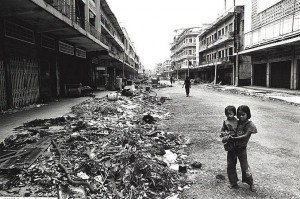 Their ‘Agrarian Revolution’ – an economic model founded on the single pillar of self-sufficient rice production – was to have a cataclysmic impact on all aspects of systemic diversity: social, cultural, economic and environmental.
Their ‘Agrarian Revolution’ – an economic model founded on the single pillar of self-sufficient rice production – was to have a cataclysmic impact on all aspects of systemic diversity: social, cultural, economic and environmental.
All those who threatened their ideological dominance were murdered or exiled – ethnic and religious minorities, journalists, doctors, educators, writers, anyone with an education – obliterating vital cultural, intellectual and skill resources.
Urban populations were forced to leave cities, towns and former roles behind to slash-and-burn virgin rain forest, set up collective farms, and take responsibility for rice production, whilst the thousands of male peasant farmers with the requisite know-how were press-ganged into military service.
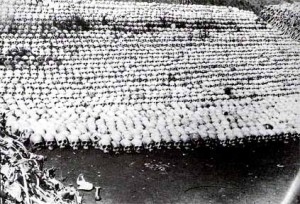 Naive farming communities went hungry rather than risk retribution for failing to meet the Government’s exorbitant rice targets, which soon resulted in a precipitous deterioration in output. Almost a quarter of the population died of starvation or execution under the regime, a disproportionate number of which were male.
Naive farming communities went hungry rather than risk retribution for failing to meet the Government’s exorbitant rice targets, which soon resulted in a precipitous deterioration in output. Almost a quarter of the population died of starvation or execution under the regime, a disproportionate number of which were male.
Within three-and-half years, the loss of diversity and productivity had rendered the Khmer Rouge’s power base so weak, they were easily overthrown by a Vietnamese invasion.
30 years later, the Cambodian ‘system’ is still suffering. Political instability has resulted in 4 coups over the interim period. The country still has the highest proportion of women (65%), malnutrition and physical disability in South-East Asia (the latter attributable primarily to the Khmer Rouge’s estimated 4-6m unexploded mines).
The country’s economy remains dependent on tenant farmers involved in backbreaking rice production for minimum profit. Necessarily, many of these are women, creating further societal tensions by violating customary rules and roles of a traditionally patriarchal society. International development experts argue that, despite the potential for a full recovery, without external intervention the Cambodian socioeconomic system will struggle to escape the impoverished, fragile state in which it was left by the Khmer Rouge.
 Conversely, ‘laissez faire’ ruling groups, such as The Ancient Greeks and Romans, that implemented policy and infrastructure which nurtured the (5/6) ‘socioeconomic diversity engine’ tended to produce history’s more enduring and resilient regimes. For example, in the mid c14th a nascent Western European civilisation – arguably, the most pluralistic, productive and market-driven the world had yet seen – successfully weathered a perfect storm of catastrophe that would have devastated a weaker social system, including climactic cold spells, famines, widespread peasant revolts, The Black Death, and an overall loss of quarter of the population.
Conversely, ‘laissez faire’ ruling groups, such as The Ancient Greeks and Romans, that implemented policy and infrastructure which nurtured the (5/6) ‘socioeconomic diversity engine’ tended to produce history’s more enduring and resilient regimes. For example, in the mid c14th a nascent Western European civilisation – arguably, the most pluralistic, productive and market-driven the world had yet seen – successfully weathered a perfect storm of catastrophe that would have devastated a weaker social system, including climactic cold spells, famines, widespread peasant revolts, The Black Death, and an overall loss of quarter of the population.
Nevertheless, (6b) although these ‘laissez faire’ strategies yielded prosperity for ruling groups, they also entailed a diminishing of their control over rules and resources as increasingly pluralistic and influential populations demanded ever greater democratic freedoms, rights and representation.
As we shall discuss in Week 4, this shift would ultimately give rise to a global economic elite whose power, and impact on diversity and stability, would dwarf that of any political ‘ruling group’. However, before we do, we thought it worth taking a moment to understand why it is that an ecosystem or ‘civilisation’ is more stable if it is diverse? Hope you’ll join us next Friday to find out.
Recent Posts
- Seeding a Viable Economic Alternative. Pt 3: Placing Mother Nature First
- Seeding a Viable Economic Alternative. Pt 4: Ego-as-Process
- Charlie Hebdo and the Immorality Loop
- My Top 20 Waterfalls Pt3 (S America: #2-1)
- My Top 20 Waterfalls Pt2 (S America: #7-3)
- My Top 20 Waterfalls Pt1 (Africa, Asia, Europe & N America)
- Positive Change using Biological Principles, Pt 4: Principles in Action
- Positive Change using Biological Principles Pt 3: Freedom from the Community Principle
- Positive Change using Biological Principles Pt 2: The missing Community Principle
- Positive Change using Biological Principles, Pt 1: The Campaign Complex
- Seeding a Viable Economic Alternative. Pt 2: The Principal Themes (Outcomes of a Systems Workshop at Future Connections 2012)
- Seeding a Viable Economic Alternative. Pt 1: The Action Plan (Outcomes of a Systems Workshop at Future Connections 2012)
- What I Learned from Destroying the Universe
- Why Corporate Regulation is a Socioenvironmental Necessity. Part 5 of 5: How do We Create a Diverse and Stable Economic System?
- The Root of all Evil: how the UK Banking System is ruining everything and how easily we can fix it.
- What is Occupy? Collective insights from a ‘Whole Systems’ Session with Occupy followers
- Why Corporate Regulation is a Socioenvironmental Necessity. Part 4 of 5: Why does the current Economic System tend towards Uniformity and Instability?
- Why Corporate Regulation is a Socioenvironmental Necessity. Part 3 of 5: Why does A Diverse System = A Stable System?
- Why Corporate Regulation is a Socioenvironmental Necessity. Part 2 of 5: Why does (did) Civilisation tend towards Diversity and Stability?
- Why Corporate Regulation is a Socioenvironmental Necessity. Part 1 of 5: Why do Ecosystems tend towards Diversity and Stability?





